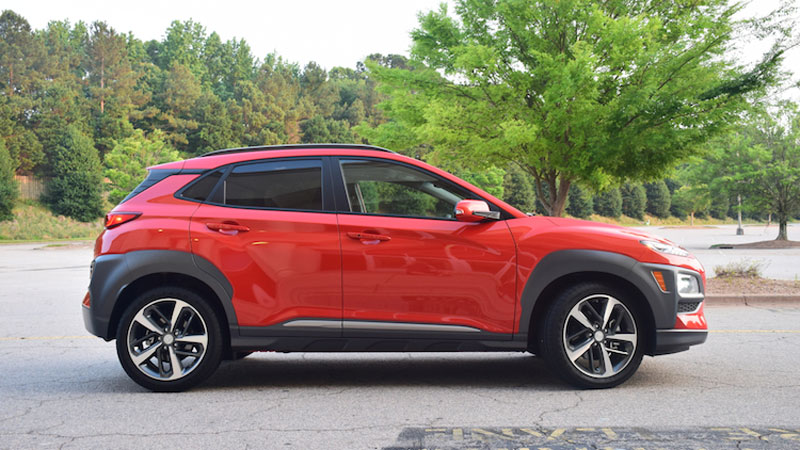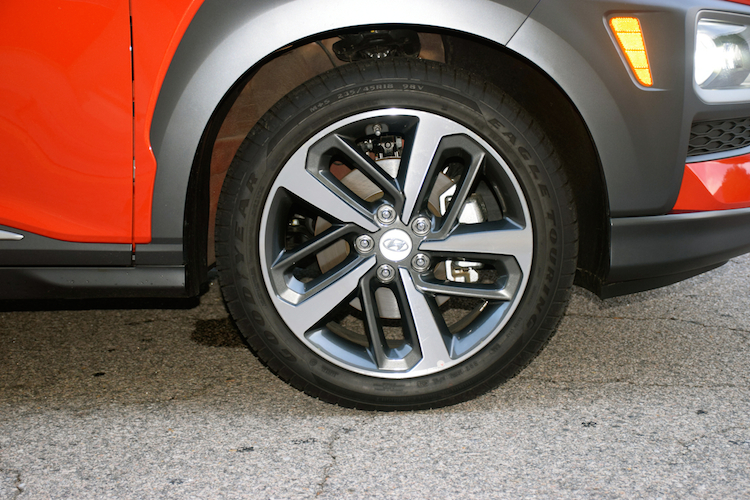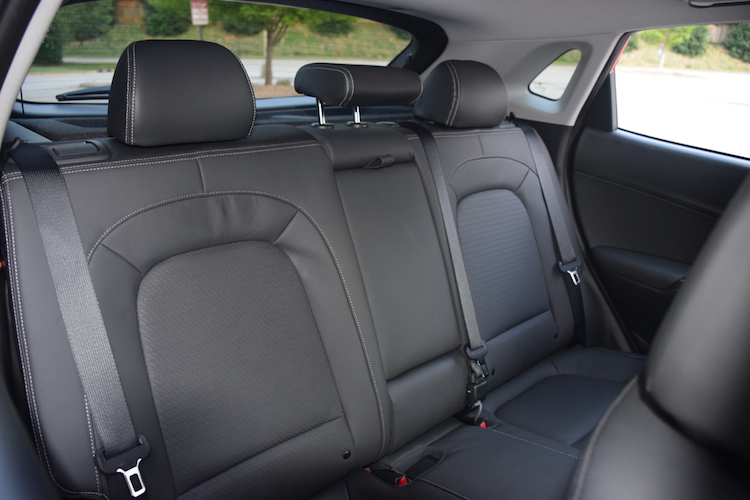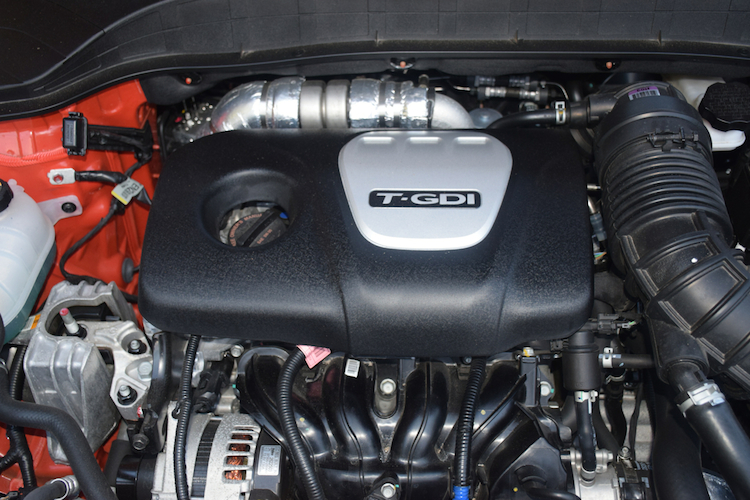Hyundai’s smallest crossover is big on value and amenities.
We’re fans of the Hyundai Kona and the reason is quite simple: this subcompact crossover utility vehicle is big on value, looks, and amenities.
The Kona rolled out in 2018 and features light changes this year, including newly added dual front USB outlets, standard forward collision-avoidance alert, and various package changes. A Sunset Orange color option is also new, which happened to dress our test model.
2019 Hyundai Kona Review
Several local trips and one long regional excursion revealed just how capable the Kona is. Around town, its small footprint is ideal for navigating narrow roads, making tight turns, and for parallel parking.
The Kona’s wheelbase sits nearly evenly between two Hyundai small cars — Accent and Elantra — but its overall length is about nine inches shorter than the Accent.
Looks wise, the Kona reminds us somewhat of an earlier utility vehicle, the Nissan Juke. Both models have an extraordinarily unusual front fascia with bold lighting elements.
Where the now-retired Juke’s visage is more polarizing, the Kona seems to pull it off with a tasteful balance of sportiness and elegance. Yes, the lighting elements seem borrowed from another vehicle too — the first-generation Jeep Cherokee.
But the Kona is its own vehicle. In fact, it offers a distinct departure from other Hyundai models, including the compact Tucson and midsize Santa Fe. There are some design elements that will appear in the upcoming Palisade, yet you won’t have any trouble distinguishing the Kona from other Hyundai models or other crossovers for that matter.
Inside, the Kona offers ample space up front and average-at-best space in the rear. The driver and front passenger have the best seats in the house and they’re dressed in either cloth or leather, depending on the trim.
The base SE has manually adjustable front seats, while other trims offer a power driver’s seat. Heated front seats are standard on all, but the base trim, a welcome feature on chilly mornings — even in May.
The rear bench seat is a 60/40 split fold-down arrangement and does something most don’t do in this segment — slightly recline. On paper, the seat holds three, but is ideal for two. Legroom is tight, except for youngsters. Most shoppers looking for ample rear seating space should begin their search with the Tucson.
Behind the rear seat is 19.2 cubic feet of storage space, which is small, but about average for tinny crossovers. Fold down the rear seat and storage capacity mushrooms to 45.8, which will easily hold a week’s worth of luggage for two or give you the ability to stuff in your yard sale finds.
You won’t purchase the Kona if you have towing in mind. Despite what some sources indicate, Hyundai says towing isn’t recommended. On the other hand, the Ford EcoSport outfitted with an aftermarket towing package pulls either 1,400 or 2,000 pounds.
We like that Hyundai is a consistent tech leader across its model line. Beyond Android Auto and Apple CarPlay smartphone compatibility, the Kona offers a standard 7-inch touchscreen display. Its bundled with the USB ports, auxiliary input jack, Bluetooth, and six speakers, giving shoppers a great place to start.
The list of upgrades includes an 8-inch touchscreen display, an 8-speaker Infinity audio system, and connected services, including navigation. Our test Ultimate model had it all.
On the safety front, Hyundai goes beyond the required rear vision camera to include lane keeping assist, forward collision-avoidance assist, and driver attention warning on all trims. The second-level SEL (one of five trims), adds blind-spot warning, lane change assist, and rear cross-traffic collision warning.
Pedestrian detection and parking distance warning appear on the two top trims as does heads-up display. Speaking of the latter, Hyundai employs a nifty translucent screen that emerges from the dashboard to display vital information.
Hyundai supplies two engine choices, including a 2.0-liter four-cylinder engine with 147 horsepower and 132 pound-feet of torque. This engine works with a six-speed automatic transmission. Beginning with the middle Limited trim, a turbocharged 1.6-liter four-cylinder engine with 175 horsepower and 195 pound-feet of torque.
This engine works with a seven-speed dual-clutch transmission. All models have standard front-wheel drive and available all-wheel drive.
Our test model had the turbo engine and all-wheel drive. This combination provides generous zip and superior handling, and that’s something most small cars do not deliver. On twisty roads, there is some body roll, but that’s typical of this vehicle type.
We like that the Kona pushes away from a dead stop with authority and has generous passing power. The EPA gives the Kona a combined fuel economy ranging from 27 to 30, which is better than the Ford, but behind the Mazda CX-3.
The price spread between the lowest and highest cost Kona models is higher this year, due to the special Iron Man Edition, which is a movie tie-in. Otherwise, the difference between the SE and Ultimate trims is $7,600 or $10,560 for the Iron Man. Add $1,400 for all-wheel drive.

We think the Hyundai Kona represents a strong entry in the subcompact SUV segment. Look beyond the base trim and the list of amenities is impressive. Start with the Limited trim and the better of the two engine choices is present.
Besides the Ford and Mazda models, you’ll want to cross-shop the Kona with the Nissan Kicks and Rogue Sport, Chevrolet Trax, Toyota C-HR, Jeep Renegade, Honda HR-V, Fiat 500X, and the Subaru Crosstrek. The Kona is one of the newest of the lot and perhaps the best model in the segment.
See Also: 276-hp 2022 Hyundai Kona N
2019 Hyundai Kona Specifications
| Hyundai | 2019 Kona |
|---|---|
| Segment | Subcompact Crossover SUV |
| Base Sticker Price | $21,035 (including $1,045 destination fee) |
| Price as tested | $30,195 (Ultimate AWD) |
| Standard Engine | 2.0-liter, inline-four |
| Horsepower | 147 @ 6,200 RPMs |
| Torque (lb.-ft.) | 132 @ 4,500 RPMs |
| Transmission | Six-speed automatic |
| Optional Engine | 1.6-liter, turbo I4 |
| Horsepower | 175 @ 5,500 RPMs |
| Torque (lb.-ft.) | 195 @ 1,500 to 4,500 RPMs |
| Transmission | Seven-speed dual-clutch automatic |
| Seating | 2+3 |
| Curb Weight (pounds) | 2,890 (SE FWD); 3,276 (Limited AWD) |
| Wheelbase (inches) | 102.4 |
| Length (inches) | 164.0 |
| Width (inches) | 70.9 (without mirrors) |
| Height (inches) | 61.0 |
| Head room (f,r — inches) | 39.6, 37.8 |
| Leg room (f,r — inches) | 41.5, 34.6 |
| Shoulder room (f,r — inches) | 55.5, 54.5 |
| Hip room (f,r — inches) | 53.3, 52.2 |
| Storage (cubic feet) | 19.2, 45.8 |
| Gross vehicle weight (pounds) | NR |
| Towing (pounds) | Not recommended |
| Payload (pounds) | 915/930 |
| Fuel | regular |
| Fuel Tank (gallons) | 13.2 |
| EPA Fuel MPG (city/highway/combined) | 25/30/27 (2.0L AWD); 28/32/30 (1.6L FWD)( |
| Manufacturing Plant | Ulsan, Korea |
See Also – SUV Eruption: 2018 Hyundai Kona
Photos copyright Auto Trends Magazine. All rights reserved.
- 2024 Mazda CX-50: A Compact SUV with Premium Aspirations - Apr 15, 2024
- 2024 Ford Mustang (Iconic Pony Car Evolves) - Apr 4, 2024
- 2024 Ford Maverick (Looks Like a Truck, Drives Like a Car) - Mar 28, 2024







